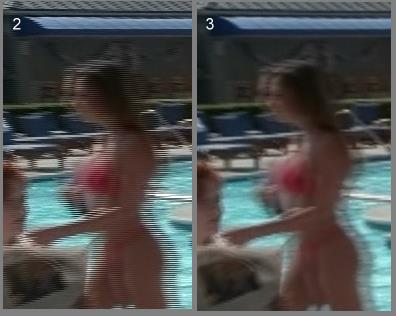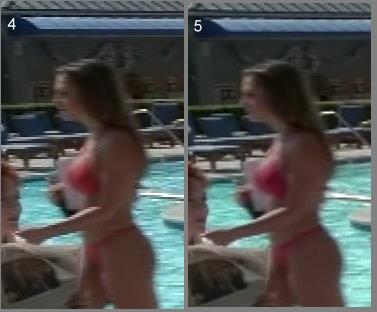New here, good site, very good source in info...
But have some questions;
I want to archive clips I catch with my camera (Panasonic 3CCD GS-120) archive to HD, then maybe recode for DVD..
MPEG-2 or MPEG-4 (Xvid) ? - Does MPEG-4 compress more efficiently or just chuck more info away?
To deinterlace - I want to do to get rid of those pesky lines.. Is the VirtualDub deinterlace 'blend' filter a good option?
When I recode from MPEG-4 (progressive) to MPEG-2 (for DVD) should I re-interlace or leave as is? is there even a difference (in effect) ?
Seems the puristst would say "don't delinterlace" or "don't compress" - But I'm not starting with broadcast quality, and can wear some loss in favour of convienience..
Cheers for any help,
Rog.
+ Reply to Thread
Results 1 to 25 of 25
-
-
MPEG2 and leave it interlaced if you're wanting to put it on DVD to watch on your TV set.
"There is nothing in the world more helpless and irresponsible and depraved than a man in the depths of an ether binge, and I knew we'd get into that rotten stuff pretty soon." -- Raoul Duke -
A related question - if you're going to watch a dvd on a progressive scan dvd player connected to a tv through the component inputs (so progressive material gets played in its progressive form, I'm assuming), why wouldn't someone deinterlace a capture of interlaced material? Won't it look better when played in this situation, even though the source was interlaced?
The reason I'm a little confused is that I always read that you should capture vhs (interlaced) to an interlaced format when you plan on burning it on dvd, because your tv is interlaced. But that doesn't take into consideration (or offer an explanation about) tv's capable of playing progressive video. And then to top it all off, I've read in at least one post that you should always capture to progressive mpeg2 (when capturing directly to mpg), because capturing to interlaced mpeg2 causes synch issues. -
although you could still have it as a progessive clip and still work fine on your dvd deck. Some dvds are made as progressive (as is the case of this one dvd i backed up and i am trying to re-edit with)
but essentially you still would want it as an interlaced clip -
If your source is progressive (film, etc) then convert it. If your source is from a digital camera then it's interlaced and you should encode it that way. Converting actual interlaced source to progressive won't look right when it's played back.
"There is nothing in the world more helpless and irresponsible and depraved than a man in the depths of an ether binge, and I knew we'd get into that rotten stuff pretty soon." -- Raoul Duke -
I tried this - Used Virtualdub to deinterlace the DV, and save as uncompressed RGB, then encoded as progressive DVD. I couldn't see an obvious difference. I do use component cables (if that's important?)Originally Posted by mazinz
I would guess that it would be more obvious where there's a high rate of change bewteen frames?
Other thing is unless MPEG-4 can acheive similar quality with 3-4 times the compression rate over MPEG-2 then it's hardly worth it & I'll just archive with MPEG-2.
Cheers, -
Match the source. The end.
Want my help? Ask here! (not via PM!)
FAQs: Best Blank Discs • Best TBCs • Best VCRs for capture • Restore VHS -
For archiving I recommend saving your DV files on ISO disks.
If you must convert to MPEG I would recommend MPEG 2 over MPEG 4. MPEG 4 is much better at low bitrates (below 3000 kpbs with D1 video) but above that there isn't much diffference. I would even say MPEG 2 has the edge at 8000 kbps. With the XVID codec anyway.
If your archiving you should leave your files interlaced. Once you've deinterlaced true video (as opposed to inverce telecining movies) you can never restore the original interlaced picture.
VirtualDub's blend mode of deinterlacing simply blurs the two field together. It's really ugly. -
What de-interlacing would you recommend?Originally Posted by junkmalle
I guess all I'm trying to achieve is acceptable quality at about 1500kbs.. I've been buggering around with Xvid 1.0.1 settings but can't find a decent setup. Always seems jerky - on the PC monitor at least.
Failing that archiving with MPEG-2 using vbr @ 6kbs gives a good result. -
You shouldnt see the interlaced lines that are annoying you if you captured it correctly and use a decent player to play it back like Media Player Classic. When I capture with Premiere Pro I use the default field settings which is Lower Field.
Never convert interlaced footage into progressive because its throwing away information. -
Not sure I have the chance to bugger it up - I'm using WinDV to download the DV from my camera. When I play the DV avi with Media Player Classic can still see the interlace lines. Would it be a setting/codec elsewhere?Originally Posted by Muppet Meat
-
I dont know how you were able to capture with Vdub because Vdub uses the VFW codec which is not on WinXP. Did you install something that fouled your system like that Panasonic DV codec??
If thats what you did you might want to try a clean reinstallation of XP if you know how. In the meantime try checking your videohelp.com inbox because i just sent you my email address there in a private message. ScenalyzerLive is probably something you should have unless you have Premiere Pro like I do. Anyways like I said before. If you are seeing interlaced lines you captured it poorly or played it with a bad player. Media Player Classic or even Windows Media Player should play it well so I think you are having a capture problem or you fouled your system with some kind of software.
I try to keep my system lean as possible. I install XP Pro followed by device drivers then I install Direct X 9 followed by the Adobe Video Collection, Nero Burning Rom, Kerio Firewall and My favorite game Battlefield Veitnam. I would say thats a fairly lean system in my view. -
You can see the interlacing lines because you are watching it on a progressive display. Use PowerDVD to play it, I believe that does 'on the fly' de-interlacing for when watching on a PC monitor.Originally Posted by rogerkip
If your main TV is progressive (plasma, LCD) then lete that do the de-interlacing for you, it will be much better than you can achieve with virtualdub. -
Here are some samples of deinterlacing techniques used by a few programs:



Crop 1 is an inverse telecined frame from the movie Women vs Men. This is provided simply as a reference.
Crop 2 is an interlaced image of the same frame and the frame before it.
Crop 3 is the same interlaced frame as Crop 2 deinterlaced with VirtualDub's Blend method.
Crop 4 is the same interlaced frame as Crop 2 deinterlaced with VirtualDub's Duplicate Field 1 method.
Crop 5 is the same interlaced frame as Crop 2 deinterlaced with Ulead Media Studio Pro 7's deinterlace method. (Note: I realize these images are from copyrighted material. But since they represent only a tiny portion of the original work, and are provided here for educational purposes, I assume this is "fair use" as provided by law in the USA.)
In these examples the two fields were taken at 1/24 second intervals since it comes from a film that has been telecined (recorded off digital cable). If this had been shot with a DV camcorder the two frames would have been taken at 1/60 second intervals instead. There would have been less motion between the two fields but comb-like interlacing artifacts would still be visible.
As you can see in Crop 3, Virtual Dub has simply blurred the two fields together. It looks like a lot like a double exposure. When you view this on a TV you will see the blurry image over both fields.
Crop 4 was created simply by throwing away field 2 and substituting field 1 in it's place. You can see lots of stair stepping artifacts. Especially on the left arm of the woman in the bikini.
Crop 5 was created by throwing away one field, and creating the second field by interpolating from the first field. Each pixel in field 2 is an average of the pixel above and below it in field 1. You can still see a bit of stair stepping but it's not nearly as bad as in Crop 4.
If forced to deinterlace I would use Media Studio Pro's method. But the best thing to do for archiving is to leave the video interlaced. When you view it on TV you won't see the artifacts because you don't see both fields at the same time. When viewing on the computer you can use an on-the-fly deinterlacer like Bugster recommended. -
Nice comparison job! (nice choice of frame too
 )
)
Convincing stuff for the argument not to deinterlace, I'm sold...
Now I've played with it some more and have dumped some video to M2P & play it with media player classic have found that way interlacing is obvious (as some have pointed out) - as opposed to playing raw DV or MPEG-4 with the same...
But that's it, learnt my lesson, will do all my archiving to MPEG-2...
Rog.. -
That's what I've heard, however what about in the recently-posted "VHS to DVDR Guide", found here:Originally Posted by lordsmurf
https://www.videohelp.com/forum/viewtopic.php?t=228057&highlight=
He says that if capturing directly to mpeg-2, you should capture to progressive mpeg-2. I could be wrong, but when capturing to avi, it also looks like he de-interlaces during the avi to mpeg-2 encoding.
This seemed like a solid guide, and all the responding posts seemed to agree, so was this just an overlooked error in this guide or what? -
No,Originally Posted by Brent212
He says that his choice of mpeg-2 capture app "Cyberlink PowerVCR II" captures in progressive mpeg-2.
Yes, the avisynth script is de-interlacing. It looks to me as if he is doing this because his source avi is the wrong size for DVD, the last line of the script is the resize. In this case de-interlace is necessary as you cannot correctly perform a vertical resize on interlaced material. If your source avi is DV, it is already the correct size, so resizing and therefore de-interlacing is not required. -
I see you're point about de-interlacing if you are verticly resizing the material. One thing I'm not sure of now, though, is whether doing a vhs capture (when capturing at 720x480) is resizing the video at all. My guess is no, which is why everyone says to leave this type of capture interlaced.
Also, here's what I was referring to when I said the guide recommends capturing to progressive mpeg-2.
"I do not suggest attempting captures of VHS to interlaced MPEG-2. I have had zero success capturing to interlaced MPEG-2 where audio and video remained in sync. "
Maybe this is just saying that audio-video synch is more important than a little loss in quality (or whatever the consequence is of de-interlacing interlaced material). -
Well, thats just one persons experience with one or a small selection of tools. If you want to capture VHS direct to mpeg-2, and the tools you use support interlaced capture, try it, it may work for you.Originally Posted by Brent212
-
That's what I've been doing, with decent results. The whole point of my inquiry was to find out if there's any reason I should switch to de-interlacing my captures. The guide writer seemed to be more experienced than myself, so I thought there might be an improvement in quality by capturing to progressive mpeg-2.
-
Here's what I suspect is happening: When he captures interlaced video the computer has to capture two fields every 1/30 of a secon. When he captures "progressive" the computer is capturing a single field using methods 4 or 5 I described above. This is half as much work to do (for the capturing part anyway) in that 1/30 of a second. I suspect he is dropping frames when capturing both fields, therefore losing audio sync. A very common problem.Also, here's what I was referring to when I said the guide recommends capturing to progressive mpeg-2.
"I do not suggest attempting captures of VHS to interlaced MPEG-2. I have had zero success capturing to interlaced MPEG-2 where audio and video remained in sync. " -
In case anyone is interested: for movies on VHS tape, I capture as interlaced 720x480 then inverse telecine back to the original 24 fps film. I find that to be the best solution.
-
Can you inverse telecine an mpeg-2 (I used a hauppauge pvr-250, which only captures to mpg)?
Also, how do you find out what the original fps is? Most of the vhs tapes I capture are skateboard videos, so I'm wondering what the original frame rate is. -
Yes you can. You can resize however you like. That does affect interlace. Interlace is not size-bound. Consider the image 2 dimensions. Interlace is a 3rd dimension, not counted or touched.
PowerVCR can capture interlace if you follow my guide to turn that mode on.
There is no reason to IVTC or TC tv captures, as it was NEVER TC to begin with. It is so far embedded into interlace land that you cannot even get movies to IVTC anymore, just does not look right most times.Want my help? Ask here! (not via PM!)
FAQs: Best Blank Discs • Best TBCs • Best VCRs for capture • Restore VHS -
Brent212,
I use a Hauppauge PVR 250 too. I inverse telecine 12 mbps MPEG files from it (movies on VHS tape and cable TV) all the time.
Sometimes I can IVTC a whole movie in one piece. Sometimes I have to do it in two or more pieces because the telecine loses sync in the middle of the movie. It always happens at a scene change so I assume it is because the movie has gone through some final editing on video tape, or it's on two or more tapes at the broadcaster. Occasionally there are so many breaks in the telecine pattern that it's just not worth the trouble.
Most movies are telecined from 24 fps film. I don't know about skateboard videos. If they were from live broadcast competitions they're probably 60 field per second video which can't be IVTC'd. You can open the MPEG files in VirtualDubMPEG and step through frames. 24 fps telecined films have a characeristic pattern where you see three frames with no interlaced artifacts followed by two frames with interlaced artifacts.
Similar Threads
-
Progressive Vs Interlaced?
By shagratt71 in forum Video ConversionReplies: 4Last Post: 26th Dec 2011, 10:22 -
Progressive AVI encoding to DVD in TMPEnc - interlaced?
By Xoanon in forum Authoring (DVD)Replies: 16Last Post: 9th Jan 2009, 12:01 -
DVD encoding issuses w/ progressive fames plays back as interlaced. SOLVED!
By ty1er in forum DVD RippingReplies: 1Last Post: 19th Aug 2008, 09:34 -
Interlaced MPEG-2 to progressive WMV9/H.264 converter/editor
By Dark Alpha in forum Video ConversionReplies: 1Last Post: 14th Jun 2008, 15:15 -
30FPS Progressive to PAL Interlaced? (DSC MJPEG AVI to DVD)
By ezekiel42 in forum Video ConversionReplies: 7Last Post: 8th Jul 2007, 23:53




 Quote
Quote